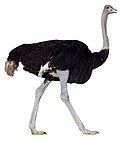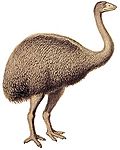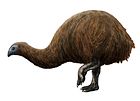|
Casuariiformes
The Casuariiformes /kæsjuːˈæri.ɪfɔːrmiːz/ is an order of large flightless birds that has four surviving members: the three species of cassowary, and the only remaining species of emu. They are divided into either a single family, Casuariidae, or more typically two, with the emu splitting off into its own family, Dromaiidae. All four living members are native to Australia-New Guinea,[3] but some possible extinct taxa occurred in other landmasses. Systematics and evolution The emus form a distinct family, characterized by legs adapted for running. The total number of cassowary species described, based on minor differences in casque shape and color variations, formerly reached nine.[4] Now, however, only three species are recognized, and most authorities only acknowledge few subspecies or none at all. The fossil record of casuariforms is interesting, but not very extensive. Regarding fossil species of Dromaius and Casuarius, see their genus pages. As with all ratites, there are several contested theories concerning their evolution and relationships. Some Australian fossils initially believed to be from emus were recognized to represent a distinct genus, Emuarius,[a] which had a cassowary-like skull and femur and an emu-like lower leg and foot. In addition, the first fossils of mihirungs were initially believed to be from giant emus,[b] but these birds were completely unrelated. It has been suggested[who?] that the South American genus Diogenornis was a casuariiform bird, instead of a member of the rheas, the current South American lineage of giant ground birds. If this were the case, not only would it extend the fossil range of this lineage to a wider region, but to a broader time span as well, since Diogenornis occurs in the late Paleocene and is among the earliest known ratites.[5] In the late 19th century, a fossil casuariid (Hypselornis) was named from India based on a single toe bone, however it was later shown to belong to a crocodilian.[6] An especially interesting question regarding this order is whether emus or cassowaries are the more primitive form, if either. Emus are generally assumed to retain more ancestral features, in part because of their more modest coloration, but this does not necessarily have to be the case. The casuariiform fossil record is ambiguous, and the present knowledge of their genome is insufficient for comprehensive analysis. Resolving the cladistic issues will require combination of all these approaches, with at least the additional consideration of plate tectonics. TaxonomyCasuariiformes (Sclater, 1880) Forbes 1884[7][8][9]
FootnotesReferences
References
External linksWikimedia Commons has media related to Casuariiformes. |
||||||||||||||||||||||||||||||||||



